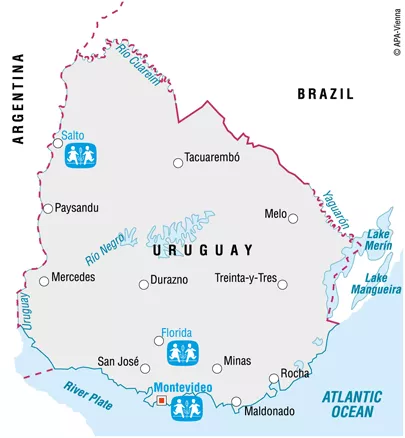
SOS relies on the kindness and generosity of Canadians to be able to provide a home for the most vulnerable children around the world.
By becoming a child sponsor you are helping an individual child in need.
(You will receive a Canadian charitable tax receipt)
Please help us ensure a loving home for every child. Sponsor a child in South America now.
For just $39/month you can sponsor a child and help provide an orphaned or abandoned child with:
- A safe and nurturing home
- A loving SOS mother
- Quality education
- Healthcare
- Nutritious food
- Clothing and toys
- All the things necessary for a bright future
SOS Children's Villages in Uruguay
At present, there are three SOS Children's Villages in Uruguay. They are located in Montevideo, Florida and Salto and include SOS Youth Programmes and a number of SOS Social Centres. In Uruguay, the SOS story has been a complete success, also thanks to the good cooperation with local and national authorities.
Since the late 1990s, the work of SOS Children's Villages Uruguay has concentrated on preventative care in both the fields of child welfare and health. SOS Children's Villages Uruguay is also operating a family strengthening programme, helping children who are at risk of losing parental care to grow up within a caring family environment. Children whose parents cannot take care of them will find a loving home in one of the SOS families.

Some facts about Uruguay
The Republic of Uruguay is situated in the south-east of South America. It borders Brazil in the north and east, the Atlantic Ocean in the east, Argentina in the west and the extensive estuary of the Río de la Plata in the south. During the colonial period, Spanish settlement in Uruguay was fairly limited, mainly due to the absence of gold and silver in the region. Initially claimed by Argentina but later annexed by Brazil, Uruguay finally declared its independence in 1828.
Owing to mass immigration from the old continent in the late 19th century, most Uruguayans are of European origin. The country saw years of repressive military rule between 1973 and 1985. However, present-day Uruguay is one of the most stable nations in the region. In 2002, neighbouring Argentina went through an economic crisis of unprecedented magnitude.
Since the Uruguayan and Argentinian economy are inextricably tied together, the economic meltdown that shook Argentina also drove Uruguay into recession. According to the Democracy Index, Uruguay is the only Latin American country that is considered to be a “full democracy”. Montevideo, a city of roughly 1.8 million, is not just the capital of Uruguay; it is also an important port and the country's commercial centre.
Situation of the people
Both politically and economically, Uruguay is perceived as one the most stable and developed countries in Latin America. No other nation in the region is more supportive of democracy and more satisfied with the way it works than Uruguay. In 2008, 82 per cent of Uruguayans supported democracy, stating it was their preferred political system. The country's adult literacy rate is among the highest in Latin America, a result of the population's wide access to education.
Uruguay is characterized by a comparatively large middle-class and income inequalities may not be as pronounced as in other Latin American countries. In fact, the Gini coefficient for Uruguay shows that wealth is more equally distributed than in Portugal. Nonetheless, the economic crisis in 2002 did have an impact on the country's poorest: in a country that was once known as “The Switzerland of Latin America”, roughly 10 per cent face a life in poverty.
In 2007, during the worst flooding the country had seen in 50 years, 12,000 people had to be evacuated from their homes. Most people affected by the disaster came from poor, disadvantaged communities. Public infrastructure, such as water supply, sewer systems and power lines, was severely damaged by the flooding.
Situation of the children
In 2007, more than 99 per cent of children between the ages of 6 and 11 attended primary school, one of the best figures in Latin America. Although access to education is generally good, Uruguay is marked by significant educational gaps. In rural areas, dropout levels are as high as 27 per cent. High dropout rates are particularly common among the poor. Since education is often seen as the key element in helping children develop their full potential, failing in school often has relevant poverty and inequality implications for the child's adult life.
Child poverty may not be as visible as in many other Latin American nations. However, the sight of children forced to work and beg in the streets to help support their parents is not uncommon in Uruguay.
The HIV/AIDS prevalence rate in Uruguay is roughly 0.5 per cent. However, the number of new infections has been on the rise over the past few years. Among the most vulnerable sections of Uruguay's population to contract HIV/AIDS are commercial sex workers, street children and injection drug addicts. They show a rather high HIV/AIDS prevalence rate of around 5 per cent. Orphans who have lost their mother due to HIV/AIDS face a high risk of ending up in poverty. They also frequently have to deal with discrimination, abuse and neglect by other members of society.
Our Impact
Image
Orphaned and Abandoned children |
3 VILLAGES | 282 Orphaned and Abandoned Children |
Image
Youths in our care |
3 YOUTH FACILITIES | 136 Youths in our Care |
Image

Youth and adult students |
1 VOCATIONAL TRAINING CENTRES | 101 Youth and adult students |
Image

Beneficiaries |
4 SOCIAL CENTRES | 3552 Beneficiaries |
Our Impact






